It is surprisingly difficult to find a good backpacking pot. Not only does the pot need to be lightweight and compact, but it also has to be big enough to fit all of your food and sit well on your stove. Ideally, the pot will also have features like a built-in colander, measurement lines or a lid which you can use as a plate when backpacking with a partner.
Here I will go over the best lightweight (and UL) backpacking pots — including ones which don’t cost a fortune.
Quick Picks:
- Best Pot for UL Solo Backpacking: Toaks 750ml with bail handle
It is the light backpacking pot I reviewed at just 3.9oz. Yet is still durable and the bail handle makes it easier to use. - Best UL Pot for Two People (or Solo Pot for Foodies): Toaks 1.1L Pot with Pan Lid
The size is perfect for ziplock bag cooking for two backpackers. The extra capacity is also great for cooking real meals when solo hiking. The pan lid is ridiculously tiny but works well enough as a bowl or for mixing sauces. - Best Pot for Group Backpacking: Snow Peak Trek 1400
The pot holds 1.4L and comes with a pan lid which you can use as a bowl or for mixing up sauces for more complex meals.
Backpacking Pots Comparison Table
| Pot | mL | Ounces | Pot WxH | Material |
|---|---|---|---|---|
| Toaks Bail Handle | 750 | 3.9 | 3.75x4.375 | Titanium |
| MSR Titan Kettle | 850 | 4.2 | 4.6x3.8 | Titanium |
| Snow Peak Trek | 700 | 4.8 | 4.2x4.4 | Titanium |
| Evernew Pot and Cup | 750+400 | 5.08 | 3.7x4.65 | Titanium |
| Toaks Pot and Pan | 1,100+280 | 5.6 | 4.5x4.375 | Titanium |
| Snow Peak Trek | 900+ pan | 6.2 | 4.75x4.25 | Titanium |
| MSR Titan Kettle | 2000 | 6.4 | 6.1x4.8 | Titanium |
| Alpha Pot | 1200 | 6.6 | 5.7x3.8 | Anodized aluminum |
| Snow Peak Trek | 1,400+ pan | 7.4 | 5.5x4.5 | Titanium |
| Olicamp XTS | 1000 | 7.6 | 4.5x5.375 | Anodized aluminum |
| Alpha Pot | 1900 | 8.1 | 6.5x4.7 | Anodized aluminum |
| GSI Halulite Boiler | 1100 | 8.6 | 4.625x4.625 | Halulite |
| Alpha Pot | 2700 | 9.6 | 7.1x4.7 | Anodized aluminum |
| GSI Halulite Boiler | 1800 | 11 | 5.79x5.98 | Halulite |
| Alpha Pot | 3700 | 11.9 | 8x5.3 | Anodized aluminum |
| GSI Glacier Boiler | 1100 | 12.1 | 4.8x5.2 | Stainless steel |
Best Backpacking Pots
Evernew Titanium Pot and Cup Set
Best for: UL solo backpacking, especially if you love hot drinks
While not as well-known as some brands, Evernew has a big following with ultralight backpackers. Their titanium cookware is hand-pressed in Japan. The titanium is very thin (0.3mm) but is still very durable.
They make several different backpacking pots but I like this set best. It comes with a 400ml cup for your hot drinks and a 750ml pot for your meals. The larger pot nests into the smaller one. You can fit two 4oz/110g gas canisters into the larger pot, or one canister plus your stove and extras. The pot is too narrow to fit an 8oz gas canister.
*Note that Evernew also makes a line of non-stick titanium cookware. It is made from “an organic non-teflon, silicone-based ceramic compound” which apparently doesn’t have the health risks of Teflon.
- Capacity: 750ml + 400ml
- Material: Titanium
- Weight: 5.08oz
- Size: 3.7W x 4.7H and 3.74W x 2.36H inches
- Measurement lines: Yes
- Lid: 1
- Buy Here
Toaks 750ml Titanium Pot with Bail Handle
Best for: Solo UL backpacking
Toaks is one of the best known brands for titanium backpacking cookware. They have a lot of different options, including various capacities and shapes of pots. Their 750ml pot is the most popular option for UL backpacking. I recommend getting this version that has a bail handle. It is very useful, especially if the foldaway handles get too hot or if you run out of fuel and have to cook over a campfire.
The pot is 3.75 inches wide, which means it can nest a 4oz/110g gas canister inside and still have room for your stove. A Toaks 450ml cup or your 1L Nalgene bottle will also nest inside. If you ever need to bring another pot, this one will nest inside the Toaks 1.1L pot and pan set.
- Capacity: 750ml
- Material: Titanium
- Weight: 3.9oz
- Size: 3.75W x 4.375H inches
- Measurement lines: Yes
- Lid: 1
- Buy At Amazon, REI
Toaks 1.1L Pot with Pan
Best for: UL backpacking with two people; solo foodie backpackers, want to nest an 8oz gas canister
I love the versatility of this backpacking pot and pan set from Toaks. Because it is a two-piece set, you can make more complex meals. For example, I often eat pasta with homemade dehydrated sauce. It really helps to have a separate pan for rehydrating the sauce. When hiking with a partner, one of you can use the pan as a bowl. The pan acts as a lid, so you don’t need to bring a separate lid and save weight.
Note that the pan is ridiculously small though. If you actually want to use it as a pan, you’ll have a hard time fitting anything inside it and flipping it. The titanium isn’t nonstick, so food will stick if you try to fry in it.
As with other Toaks products, the pot and pan set is designed to nest. It will hold an 8oz gas canister inside with room for your stove on top. It can also nest with the 750ml Toaks pot or fit into a larger Toak pot.
- Capacity: 1.1L + 280ml
- Material: Titanium
- Weight: 5.6oz
- Size: 4.5W x 4.375H inches (pot), 4.375W x 1H inches (pan)
- Measurement lines: Yes
- Lid: Pan serves as lid
- Buy At Amazon, REI
Sea to Summit Alpha Pot
Best for: Aluminum backpacking pot for two or more people
The Alpha Pot by Sea to Summit comes in four different sizes: 1.2, 1.9, 2.7 and 3.7 liters. Each size pot can nestle into the larger size, making it convenient to bring multiple pots with you on group trips or car camping.
These pots are made from anodized aluminum, so they will conduct heat better than titanium pots. The bottom edges of the pot are rounded so it’s easier to clean. Another nice feature is that the handle locks the lid in place so items won’t fall out in your pack. The handle is a bit heavy so it can make it hard to balance the pot on your stove.
Note that the Alpha pots are designed to be wider and shorter. This annoyingly means the 1.2L Alpha pot is too short to fit an 8oz fuel canister. For this reason, I’d recommend the 1.9L or larger size for backpacking with a partner or in a group. Sea to Summit also sells this pot as part of a set with bowls and cups.
- Capacity: 1.9L (1.2L, 2.7L and 3.7L also available)
- Material: Anodized aluminum
- Weight: 8.1oz
- Size: 6.5W x 4.7H x inches
- Measurement lines: Yes
- Lid: Has built in strainer and locks in place
- Buy At Amazon, REI
GSI Outdoors Halulite Boiler
Best for: You want to cook real meals, even if it means carrying a slightly heavier pot
The Halulite Boiler by GSI Outdoors isn’t the lightest backpacking pot for its size. However, it is made from a special type of aluminum which conducts heat more evenly. This makes it great for backpackers who want to occasionally cook some real meals and not just boil water.
You can fit an 8oz fuel cartridge in the 1.1L pot and still have room for your stove. The lid folds over and locks in place. To release the lock, you need to squeeze then handle. Even though this is a pretty cheap backpacking pot, the handles do seem durable.
- Capacity: 1.1L (1.8L also available)
- Material: Halulite aluminum
- Weight: 8.6oz
- Size: 4.625 x 4.625 inches
- Measurement lines: Yes
- Lid: Locks in place
- Buy At Amazon, REI
MSR Titan Kettle
Best for: Solo UL backpacking when you want a slightly larger pot
The MSR Titan Kettle is an incredibly simple yet functional backpacking pot. It is small enough to be used as a mug but, at 850ml, large enough to boil water for backpacking meals. You could even cook some ramen in it or other simple meals.
I like that that pot has a slight lip to it. When the lid is on, the lip allows you to strain water. There is also a tiny steam hole vent in the lid. The handles are pretty tiny but that does mean they won’t make the pot unbalanced on your stove.
There aren’t any measuring marks inside the pot. However, the little dots from the handle attachment points happen to be located at 8oz, 16oz and 24oz on the 850ml pot. Be warned that the titanium is pretty thin, so don’t bang this pot up! Also, the pot is slightly too short for an 8oz fuel canister. They do make a 2L size though.
- Capacity: 850ml
- Material: Titanium
- Weight: 4.2oz
- Size: 4.6W x 3.8H inches
- Measurement lines: No
- Lid: Has built in spout
- Buy At Amazon, REI
Olicamp XTS Pot
Best for: Budget backpacking pot that conducts heat well
The Olicamp XTS was described by one user as “the poor man’s jetboil.” Considering how cheap it is, the XTS pot is really great. It’s lightweight and withstands scratching well. The anodized aluminum conducts heat well. It also has a cool heat transfer system on the bottom of the pot which does seem to do what it promises. There’s also an even cheaper version of the pot without the heat transfer system.
One weird thing about the XTS pot is the lid. It is made from a special type of silicone which can withstand high heat. You can cook with the lid on and it won’t melt. However, if you let the flame get too high, the lid or handles of the pot will melt – so be careful!
There is a little vent hole in the lid but it isn’t a pour spout. You’ll need to remove the lid to pour from the pot. Note that dimensions are for the inside of the pot.
- Capacity: 1,000ml
- Material: Anodized aluminum
- Weight: 7.6 oz
- Size: 4.5W x 5.3H inches
- Measurement lines: Yes
- Lid: Silicone
- Buy Here
GSI Glacier Stainless Steel Boiler
Best for: Durability or campfire cooking
As you’d expect from a stainless steel backpacking pot, this one is pretty heavy for its size. But the weight may be worth it if you want a backpacking pot which can withstand a lot of abuse and occasionally be used over a campfire.
It can hold an 8oz fuel canister and still fit a stove. The handle locks in place. I also like that the handle is long enough that it doesn’t get hot quickly. But the handle does make the pot hard to balance.
- Capacity: 1.1L
- Material: Stainless steel
- Weight: 12.1oz
- Size: 4.8W x 5.2H inches
- Measurement lines: Yes
- Lid: Locks in place
- Buy Here
Snow Peak Trek 1400
Best for: Group backpacking
Snow Peak is another great brand which makes titanium backpacking pots in Japan. Their products are really durable and have nice rounded edges for easier cleanup. The Trek 1400 is the largest size. Just the pot has a 1.4L capacity. The pan is another 0.5L, so is actually very useable. You can easily fit an 8oz fuel canister inside plus stove.
The two-piece setup and size makes the Trek 1400 the best pot for group backpacking. There is also a smaller version of this setup in which the pot has 900ml. I can’t find how big the pan is (I’ve never used it myself) but, based on my calculations, it should hold about 0.35 to 0.4L. Snow Peak also makes a Trek 700ml mug but it doesn’t have the pan.
*Note that this is available on Amazon as well as REI. For some reason, the Amazon description incorrectly lists it as being made from aluminum.
- Capacity: 1.4L + 0.5L
- Material: Titanium
- Weight: 7.4oz
- Size: 5.4W x 4.5H inches (pot), 5.75W x 1.5”H (pan)
- Measurement lines: Yes
- Lid: Pot serves as lid
- Buy At Amazon, REI
What Size Backpacking Pot?
Choosing the right size backpacking pot is a tricky balance. You don’t want it to be too big because it will be extra weight and room in your pack. But you don’t want a pot which is too small either. It will be difficult to cook meals (and thus more likely to burn food on the bottom) and you may even need to cook large meals in two batches.
Here are general guidelines on what size backpacking pot to get:
- 500-650ml pot: Choose a small pot if you are solo backpacking and mostly just need to boil water for cooking in the bag. You won’t be able to fit large meals in a small pot so only choose this if you snack a lot during the day.
- 750-900ml pot: This size is good for solo backpacking if you need to cook meals. A full bag of Knorr pasta or a pre-packaged backpacking meal will fit in with room for add-ins.
- 900-1000ml pot: If you are solo backpacking, don’t care about weight much and want to be able to stir cooked meals well. It’s also great if you want to boil water for multiple things at once, like water for your meal and a hot drink.
- 1000ml pot: If you need to melt snow when solo backpacking, you’ll need at least a 1L pot.
- 1200-1800ml pot: This is a good size for two people. Go larger if you will cook proper meals that require stirring.
Not sure which size backpacking pot to get? Choose an 800-900ml pot. It is still lightweight but you’ll be able to cook proper meals in it and actually stir ingredients. Even if you don’t “need” it, you’ll enjoy the luxury of having the extra space in the pot.
Features to Look for in a Backpacking Pot
Materials: Titanium vs. Aluminum vs. Stainless Steel
Titanium pots are definitely the most popular option with ultralight backpackers. However, they are very bad at conducting heat and you will get hot spots on the bottom of the pot. Because so many backpacking pots are insanely thin, the hot spots can be a serious problem when cooking. As one backpacker said, “There’s nothing worse than ruining your meal to save a few grams.”
If you want to cook real meals and not just boil water, then anodized aluminum is a better choice. These do a great job of conducting heat evenly. Though usually better than titanium, stainless steel isn’t great for conducting heat evenly. Stainless steel is also very heavy but will hold up better under rugged conditions.
Pot Shape
- Tall and skinny: Pots with this shape are easier to balance on tiny backpacking stoves. But the shape makes it harder to cook proper meals where you have to stir ingredients. It’s also annoying to eat from the pot.
- Short and wide: These pots are more difficult to balance on a backpacking stove but definitely more enjoyable when it comes to cooking and eating meals.
Handle Type
Most backpacking pots have foldaway handles. The handle either folds off to the sides or over the top. I personally like the handles which go over the sides instead. They are smaller, so will get hot. However, they won’t cause your pot to get off balance and fall over like some larger pots do. Also, if you want to stuff a lot of things into your pot without the lid on, you don’t have to worry about the handle getting in the way.
*If you use a windscreen with your backpacking stove, make sure it will fit with the handle. You may need to cut a hole in the windscreen for the pot handle! Here’s how to make an UL windscreen for cheap.
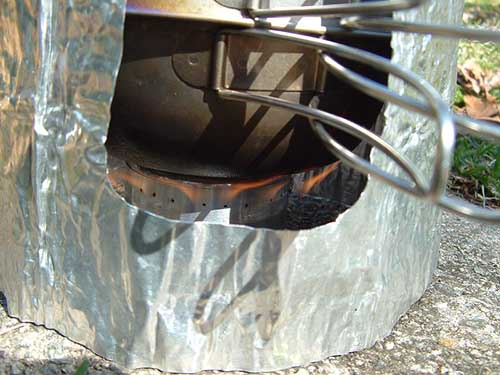
Measurements Inside the Pot
This is one of those small features which can make a big difference when backpacking. Your meals will end up being the right consistency and you won’t have to waste fuel by accidentally boiling too much water. Almost all good backpacking pots now have this feature.
Lid Function
You will need a lid for your backpacking pot to speed up boil time (and thus save fuel). Some pot lids have features like built-in strainers. In pot/pan sets, the pan sometimes can be used as a lid. I really like this feature because it allows you to save weight. Even if you don’t need the pan, you can use it as a bowl.
Does Your Stove and Fuel Canister Fit Inside the Pot?
Some of the best brands of backpacking pots are designed to perfectly hold their fuel canisters and stoves. This is a really nice feature because it will save lots of space in your pack. Just pay careful attention to the interior dimensions of the backpacking pot. Many will only hold a 4oz/110g fuel canister and not larger 8oz/230g canisters.
If the fit is really tight, you might not be able to get your windscreen or a towel around the canister (which helps prevent scratching).
Do You Eat from the Pot?
A lot of backpackers (myself included) want to eat out of the pot so they don’t need to bring an extra bowl. I personally find this annoying to do with tall, skinny pots. You’ll need an extra long spoon.
Also note that many backpacking pots should not be used with metal spoons. This includes titanium pots as well as any pot which has a Teflon coating.
Is the Backpacking Pot Safe for Campfire Cooking or Wood Fuel Stoves?
If you run out of fuel, it’s good to be able to use your backpacking pot over a fire as a backup. Not all backpacking pots are safe for open fires though. As a general rule, stainless steel is the best material followed by titanium and then aluminum. It really depends on how thick the backpacking pot walls are though.
Ideally, you would never set your backpacking stove directly on the open flame. Instead, elevate the pot (see these campfire cooking methods with no extra gear required). That’s one more reason I like the Toaks pot with a bail handle as you can easily hang it over a fire.
Price vs. Weight
A lot of backpacking pots and cook sets are incredibly pricy. These are usually ultralight backpacking pots made from titanium. When deciding whether lightweight gear is worth it, I calculate how much more I need to pay per ounce.
For example, if one pot costs $30 more but weighs 3oz less, I’m paying $10 per ounce. I consider that a pretty good deal for a backpacking pot that I will use a long time.
Sources:
https://www.reddit.com/r/Ultralight/comments/ailmk9/pot_size_and_hiker_hunger/
https://www.reddit.com/r/Ultralight/comments/5l6ekj/determining_the_right_pot_size/
https://www.reddit.com/r/Ultralight/comments/4ymmbx/pot_sizes/
https://bushcraftusa.com/forum/threads/titanium-over-fire.103525/
https://www.trailspace.com/forums/gear-selection/topics/51293.html
Image credits:
“Alcohol Stove Lit II” (CC BY-NC 2.0) by stusic,
“st2” (CC BY-NC 2.0) by vikapproved


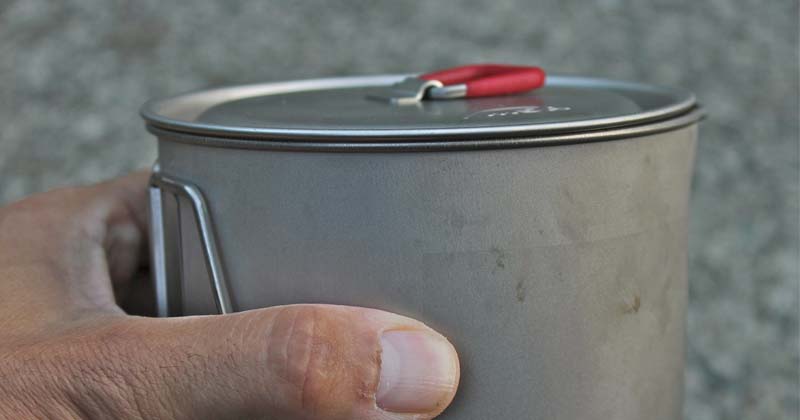
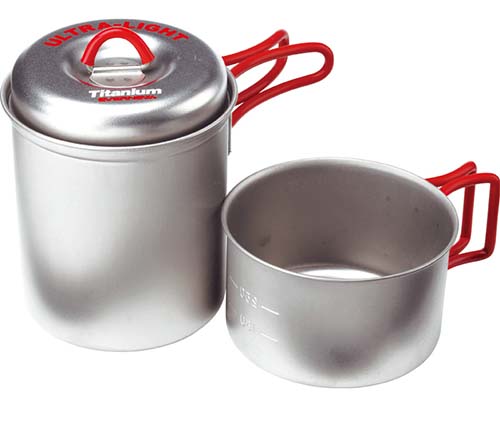
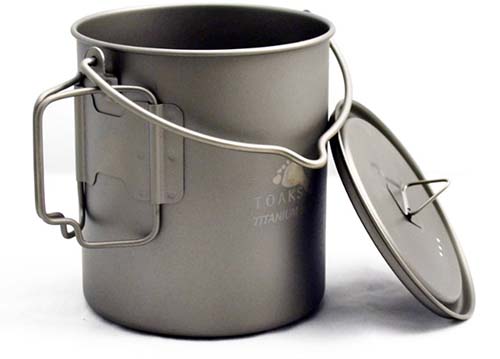
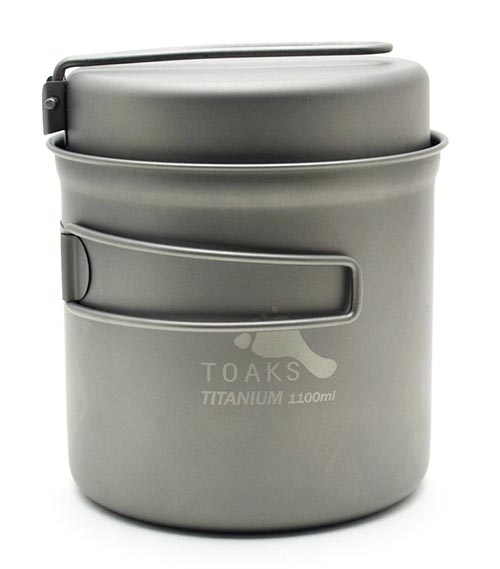
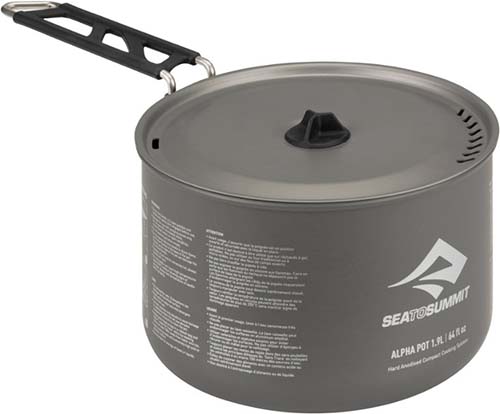
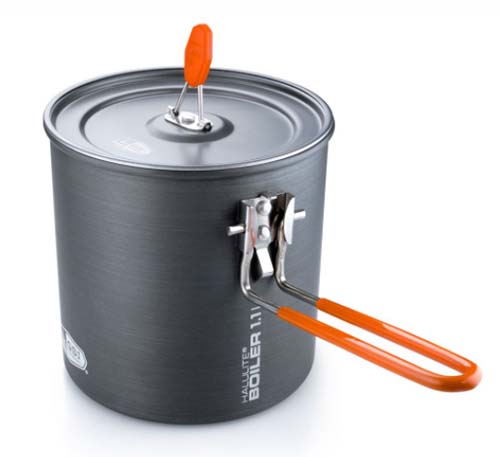
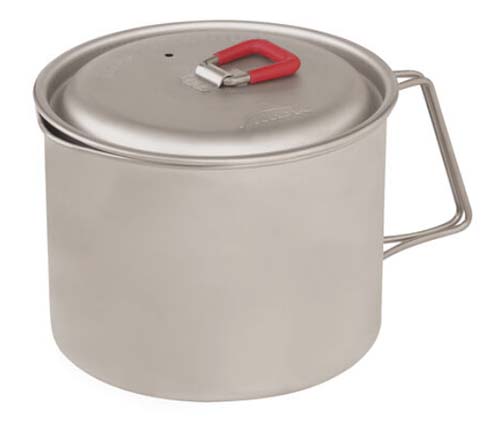
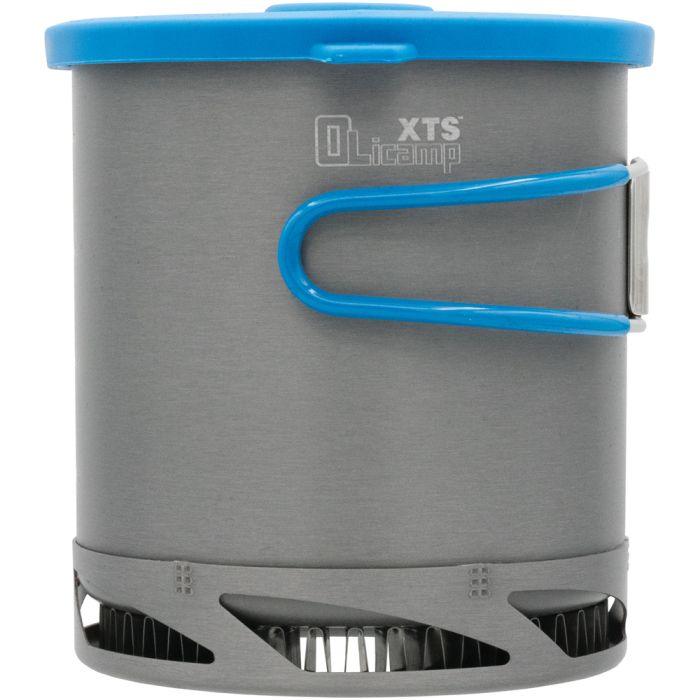
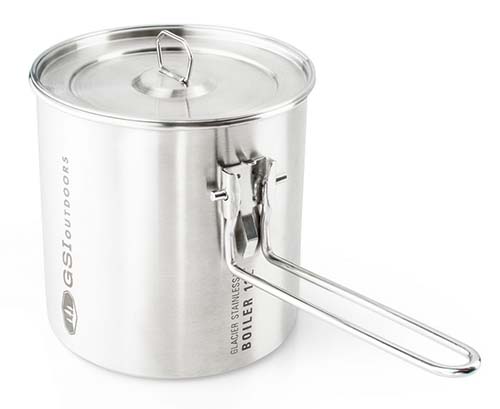
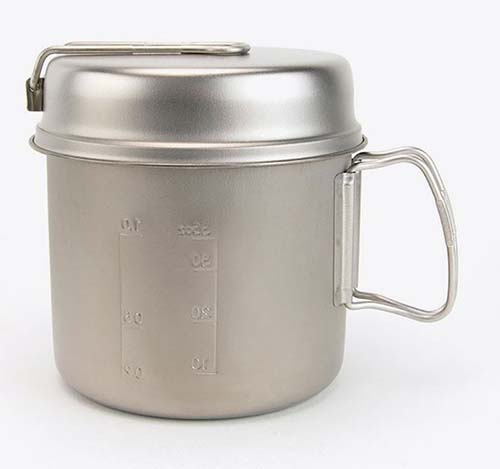

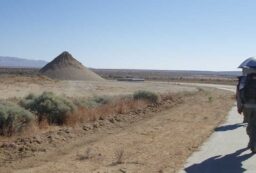
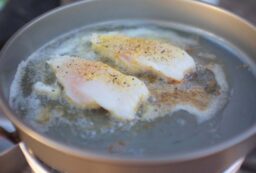







Post your comments